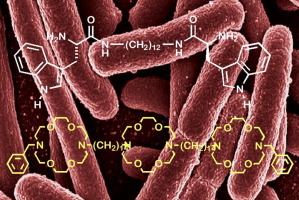Coordination Chemistry Reviews ( IF 20.6 ) Pub Date : 2020-03-05 , DOI: 10.1016/j.ccr.2020.213264 Hannah Gill , Michael R. Gokel , Michael McKeever , Saeedeh Negin , Mohit B. Patel , Shanheng Yin , George W. Gokel

|
Although synthetic amphiphiles that form ion-conducting pores have surged in interest within the chemical community, their potential as antimicrobials is little appreciated. The formation of pores in bacterial membranes has at least two obvious consequences. First, insertion of the amphiphile into the bacterial membrane results in membrane disruption or disorganization, enhancing membrane permeability. Second, to the extent that ion-conducting pores form within the membranes, ion homeostasis is likely to be affected. Changes in ion balance will have secondary effects on cytosolic proteins that may adversely affect bacterial survival.
中文翻译:

超分子孔形成作为抗菌策略
尽管形成离子导电孔的合成两亲物在化学界引起了人们的兴趣,但作为抗菌剂的潜力却鲜为人知。在细菌膜上形成孔至少有两个明显的后果。首先,将两亲物插入细菌膜会导致膜破裂或混乱,从而增强膜通透性。其次,在膜内形成离子导电孔的程度上,离子稳态可能会受到影响。离子平衡的变化将对胞质蛋白产生次要影响,可能会对细菌存活产生不利影响。



























 京公网安备 11010802027423号
京公网安备 11010802027423号